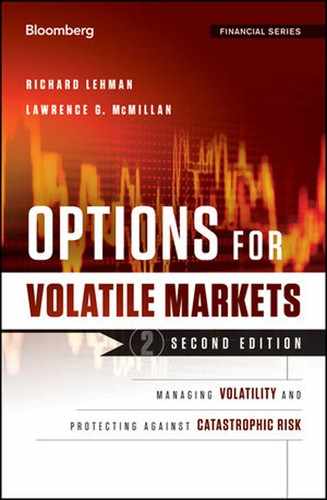Preface
,Because our previous books covered the gamut on option theory and strategies, one might reasonably ask why we felt the need to publish a new book on the subject at this time. The answer to that is twofold: (1) because there have been material developments within the world of options—new durations, new rules, new volatility instruments, and (2) more important, because there have also been significant changes in the nature of the markets and the environment for securities investing. In the interest of brevity, we referred to the new environment in the title simply as volatile markets, but that understates how extensive we feel the changes are. What we are really saying (and we expound further on this subject in the Introduction) is that today's financial markets harbor risk and uncertainties far beyond historically accepted norms, and that it is now more important than ever to manage the risks in investment portfolios on a continual basis. To that end, we still see listed options as the single most effective tool in the financial arsenal for dealing with such risk and volatility.
We still believe covered call writing is an underutilized strategy that offers equity investors a highly effective tool for reducing volatility—much more so than simply relying on security diversification. But we also feel that volatility has become more of a factor in equity investing than ever before and that the downside risks of equity investing have expanded dramatically. These risks, which are an ever-present factor in equities markets, are growing rather than receding, and have reached a level that not only requires a more potent defense against risk than covered call writing by itself, but suggest that equity portfolios should adopt a virtually continuous risk-management strategy. Yet, as we concluded in our earlier work, the mainstream investment management industry remains sorely lacking in either using options themselves or in aiding investors in using them. The events of 2008 and the “flash crash” of 2010 should have awakened professional managers in a big way to the need to hedge equity portfolios with options, but for a variety of systemic reasons, those changes have been slow to emerge. Our aim with this book is to help both individuals and money management professionals recognize that risk is very definitely a controllable entity.
In 2003, we published New Insights on Covered Call Writing because we felt that vast improvements in online tools, data, and discount brokerage services coupled with changes in options availability and reduced transaction costs had significantly changed the landscape for individual investors with regard to writing covered calls in stock portfolios. At the same time, the full-service wire houses were discouraging their reps and clients from using options and professional money managers continued to live in a stock picking world that simply didn't embrace options in a serious way. For the most part, these conditions persist. Yet, had you adopted covered call writing in the beginning of 2004 in a well diversified portfolio, you would not only have significantly reduced your volatility compared to that of the S&P 500 over the ensuing six years, you would also have handily outperformed it. Between the years 2004 and 2009, the S&P Total Return index (S&P 500 with dividends reinvested) returned 13.36 percent, while, according to the CBOE, its Buy-Write index (BXM) returned 20.54 percent for the same period.
The basic practice of covered call writing reduces volatility quite nicely (about one-third according to studies on the BXM index), but more advanced forms of option writing coupled with more powerful hedging strategies such as purchasing puts may be necessary in today's environment. Put hedging satisfies the downside protection requirement, but can be prohibitively expensive and has other drawbacks. In this book, we discuss variations of both strategies in detail as well as the use of both together to deal with today's markets. Finally, we examine the new vehicles that allow investors to actually trade volatility itself.
The first five chapters in this book represent an updated and condensed version of the basic options and covered call writing content from New Insights on Covered Call Writing. (Chapters 1 and 2 are very elementary and are included so those who have never used options before can start from scratch. Those already familiar with options may want to jump in at Chapter 3 for the basics of covered call writing.) Chapter 6 focuses on put hedging and Chapter 7 combines call writing and put hedging into collar strategies. Chapter 8 applies these option strategies to the rapidly growing field of exchange-traded funds (ETFs), and Chapter 9 explains how to utilize the new volatility instruments that are now available.
The book is addressed to the broad audience of equity investors, both individual and professional. We feel that every investor in listed equities, whether managing a portfolio themselves, or paying a broker, money manager, or mutual fund manager to manage it for them, should at least recognize that there are tools available to effectively reduce risk and volatility, and to either learn how to use those tools themselves, or find a professional who does. In particular, we hope, for the sake of millions of hardworking Americans, that the people responsible for pension and retirement assets in this country take note, as trillions of dollars in retirement assets are woefully unhedged against another calamity like 2008 or worse.
RICHARD LEHMAN
LAWRENCE G. MCMILLAN
